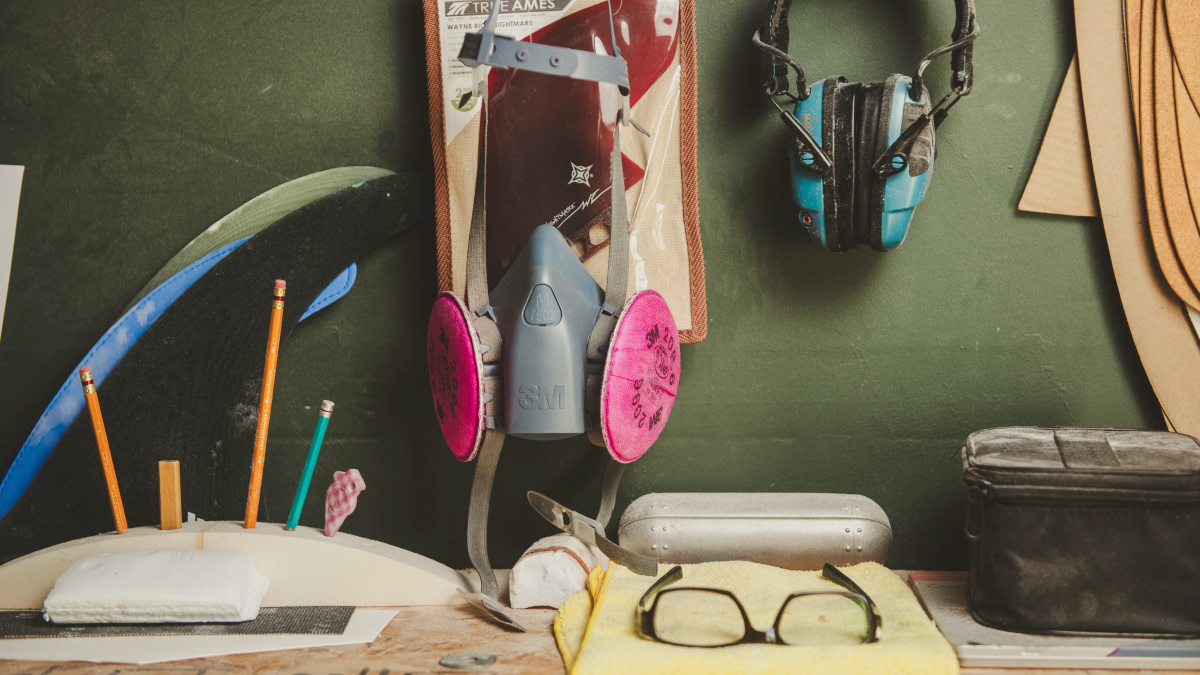Fueled by his faith, a Makaha-based surfboard shaper celebrates the art of analog.
Decades before he became one of the West Side’s most sought-after surfboard shapers, Sira “Tor” Sunnanonta was just a kid keen to create. Equipped with a knife, a sanding block, and youthful ambitions, he had a bold plan: to reshape an old, discarded board into a newly minted masterpiece. Although he was a teenager at the time, Sunnanonta presumed his skill set would serve him well: He was an avid surfer and familiar with the general tools and materials needed to make a board; in school, he excelled in mathematics—a boon for the requisite measuring involved; he also had a knack for building things. The board was a bust. “I went into it thinking, this can’t be that hard,” Sunnanonta laughs. “My mom ended up throwing it away.”
The failed endeavor nagged at him, so when he was introduced to a respected shaper and subsequently offered an apprenticeship, Sunnanonta jumped at the opportunity. Working as a “shop rat,” Sunnanonta tackled the grunt work with gusto—running errands, sweeping up foam, repairing small dings under the guidance of the senior shapers. “I was eager and hungry to learn,” Sunnanonta recalls, “and willing to clean the shop for a little wisdom.”

Sunnanonta was a quick study in all things surfboard making, soaking up everything he could about shaping, sanding, and glassing and then finetuning those techniques in meticulous fashion. He refused to take shortcuts, something that did not go unnoticed by Sunnanonta’s mentors. His methodical approach was a refreshing change from the other fledgling shapers, who grew impatient and rushed through steps. The more Sunnanonta applied himself, the more his passion grew. “I remember praying that it would be God’s will for me to make a career out of shaping,” Sunnanonta says.
After several years of study, his prayer was answered. Sunnanonta’s mentors informed him that he had finished his training—he’d been taught all there was to be taught. Moreover, he was awarded the ultimate validation: their blessing to strike out on his own.
Today, Sunnanonta works out of a shop in Mākaha, where he has transformed a trio of large shipping containers into a shaping bay, a glassing space, and a sanding room. Unlike the chaotic disarray of resin drums, brushes, and foam blanks one might find in a typical board shaper’s studio, Sunnanonta’s workspaces feel intentional and Zenlike— a shaper’s dream mise en scène. On one shelf, palm-sized sanding blocks are carefully ordered by grit. On another, rulers, rasps, and clamps are neatly lined up within easy reach. Here, everything has a place and a purpose—and, in the case of Sunnanonta’s company name, Prizm Surfboards, a deeper meaning.

When he was a child, Sunnanonta had been fascinated by the rainbow of color that a prism refracts from a beam of white light. Later, as a devout Christian, he found the prism’s physics a fitting metaphor for his faith. “The Bible talks about how God is light, and we are his vessels,” he explains. Surfboard making became Sunnanonta’s way of channeling the divine.
In the shaping room, Sunnanonta scrutinizes his latest project, his practiced eye scanning the board’s lines for aberrations. He consults a clipboard, reviewing his detailed notes before grabbing a tape measure and a handsaw. The saw, more than 100 years old, was a gift from one of his mentors. “The beauty of old tools is that everything’s very comfortable and broken in,” Sunnanonta says, marveling at the saw’s solid craftmanship.
In a new era of board shaping dominated by Computer-Aided Design (CAD) software programs and Computer Numerical Control (CNC) machines, Sunnanonta is among the rare guild of shapers still doing everything by hand. While a traditional shaping job could take days or months, tech-inclined shapers can simply plug numbers into a machine and produce one in hours. “It’s almost archaic to still use simple tools like pencils, tape measures, and electric planers when CAD programs and CNC machines can do most of that work,” Sunnanonta says. “But I had wanted to learn the old-fashioned way. I intended to preserve and perpetuate the craft.”

Sunnanonta is aware he’s a bit of a throwback in the shaping world, noting that creating a board from scratch isn’t for everyone. It’s a slow, often angst-ridden process, but it’s one he enjoys. What others might consider an overwrought, pedantic approach, Sunnanonta instead sees exquisite precision. A Prizm board is the culmination of a thousand painstakingly planned details—an ode, perhaps, to Sunnanonta’s vision of the sublime.
Learn more, visit: prizmsurfboards.com
